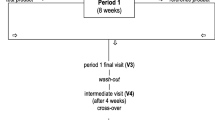Summary
The dose-response relationship of activated charcoal in reducing serum cholesterol was determined and the effects of charcoal and cholestyramine were compared in patients with hypercholesterolaemia.
In a cross-over study 7 patients ingested charcoal 4, 8, 16 or 32 g/day, and finally bran, each phase lasting for 3 weeks. Serum total and LDL-cholesterol were decreased (maximum 29% and 41%, respectively) and the ratio of HDL/LDL-cholesterol was increased (maximum 121%) by charcoal in a dose dependent manner.
Ten further patients with severe hypercholesterolaemia ingested daily for 3 weeks, in random order, activated charcoal 16 g, cholestyramine 16 g, activated charcoal 8 g + cholestyramine 8 g, or bran. The concentrations of total and LDL-cholesterol were reduced by charcoal (23% and 29%, respectively), cholestyramine (31% and 39%) and their combination (30% and 38%). The ratio of HDL/LDL-cholesterol was increased from 0.13 to 0.23 by charcoal, to 0.29 by cholestyramine, and to 0.25 by their combination. Serum triglycerides were increased by cholestyramine but not by charcoal. Other parameters, including the serum concentrations of vitamin A, E and 25(OH)D3 remained unaffected. The changes in lipids only partly subsided during the 3-week bran phase.
In general, the acceptability by the patients and the efficacy of activated charcoal, cholestyramine and their combination were about equal, but there were individual preferences for particular treatments.
Similar content being viewed by others
References
Kuusisto P, Vapaatalo H, Manninen V, Huttunen JK, Neuvonen PJ (1986) Effect of activated charcoal on hypercholesterolaemia. Lancet 2: 366–367
Friedman EA, Feinstein EI, Beyer MM, Galonsky RS, Hirsch SR (1978) Charcoal-induced lipid reduction in uremia. Kidney Int 13: 170–176
Hoekstra JBL, Erkelens DW (1987) Effect of activated charcoal on hypercholesterolaemia. Lancet 2: 455
Krasopulos JC, De Bari VA, Needle MA (1980) The adsorption of bile salts on activated charcoal. Lipids 15: 365–370
De Leenheer AP, De Bevere VO, De Ruyter MG, Claeys AE (1979) Simultaneous determination of retinol and alpha-tocopherol in human serum by high-performance liquid chromatography. J Chromatogr 62: 408–413
Parviainen MT, Savolainen KE, Korhonen PH, Alhava EM, Visakorpi JK (1981) An improved method for routine determination of vitamin D and its hydroxylated metabolites in serum from children and adults. Clin Chim Acta 114: 233–247
Ala-Houhala M, Koskinen T, Terho A, Koivula T, Viskorpi J (1986) Maternal compared with infant vitamin D supplementation. Arch Dis Child 61: 1159–1163
Neuvonen PJ, Olkkola KT (1988) Oral activated charcoal in the treatment of intoxitations: Role of single and repeated doses. Med Toxicol 3: 33–58
Tishler PV, Winston SH, Bell SM (1987) Correlative studies of the hypocholesterolemic effect of a highly activated charcoal. Methods Find Exp Clin Pharmacol 9: 799–806
Neuvonen PJ, Kuusisto P, Manninen V, Vapaatalo H, Miettinen TA (1989) The mechanism of the hypocholesterolaemic effect of activated charcoal. Eur J Clin Invest 19: 251–254
Beil U, Crouse JR, Einarsson K, Grundy SM (1982) Effects of interruption of the enterohepatic circulation of bile acids on the transport of very low density-lipoprotein triglycerides. Metabolism 31: 438–444
Angelin B, Hershon KS, Brunzell JD (1987) Bile acid metabolism in hereditary forms of hyertriglyceridemia: Evidence for an increased synthesis rate in monogenic familial hypertriglyceridema. Proc Natl Acad Sci 84: 5434–5438
Neuvonen PJ, Kivistö K, Hirvisalo EL (1988) Effects of resins and activated charcoal on the absorption of digoxin, carbamazepine and frusemide. Br J Clin Pharmacol 25: 229–233
Author information
Authors and Affiliations
Rights and permissions
About this article
Cite this article
Neuvonen, P.J., Kuusisto, P., Vapaatalo, H. et al. Activated charcoal in the treatment of hypercholesterolaemia: dose-response relationships and comparison with cholestyramine. Eur J Clin Pharmacol 37, 225–230 (1989). https://doi.org/10.1007/BF00679774
Received:
Accepted:
Issue Date:
DOI: https://doi.org/10.1007/BF00679774




